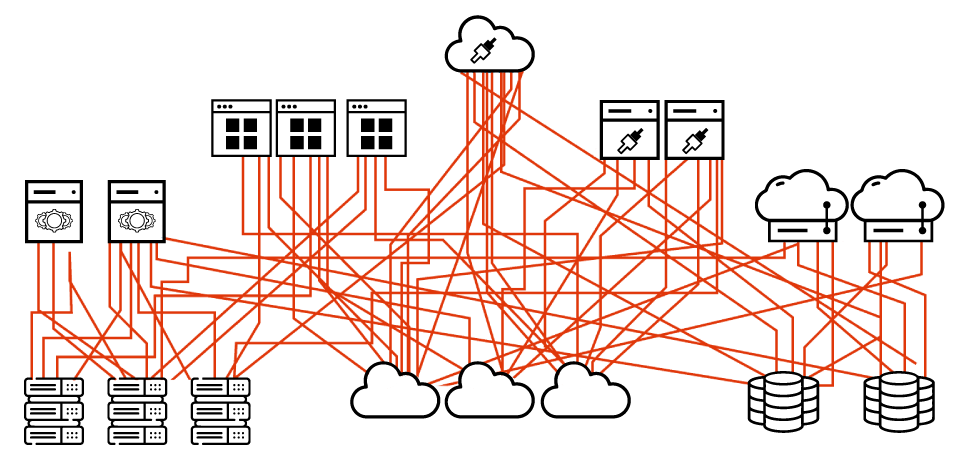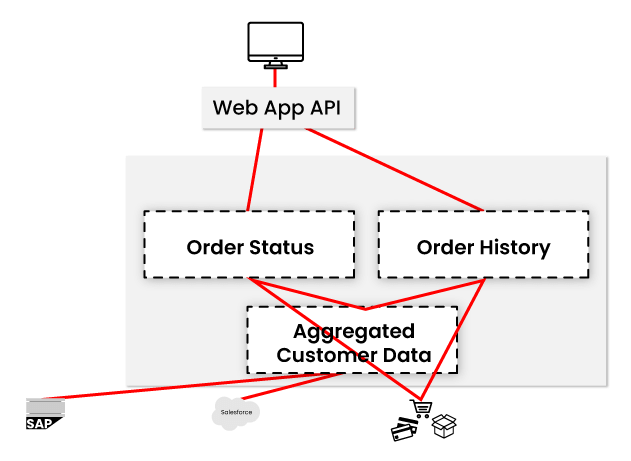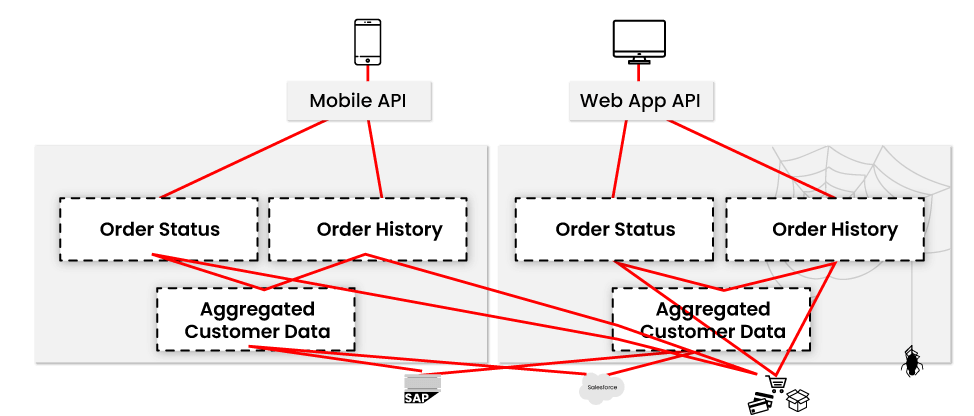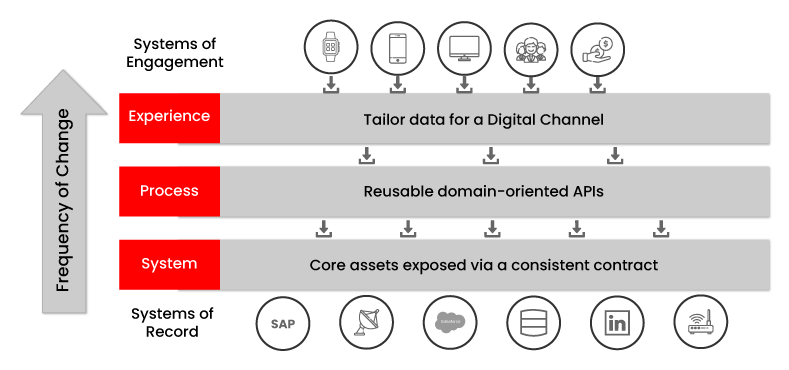
Using APIs, the Mulesoft API-Led Connection links the data to other applications. We create those APIs to carry out particular operations like adding data to processes and releasing data from systems. You will discover the significance of API-Led Connectivity and how it benefits your organization in this post about Mulesoft API-Led Connectivity.
Using specific and reusable APIs, Mulesoft's API-Led connection provides a methodical way to link data to applications. With the help of our cutting-edge API-Led technique, each integration becomes a reusable building piece. We can increase organizational agility and speed up IT delivery.
According to the Forrester Overall Economic Impact Study, Mulesoft users recovered $5.45 for every $1 they spent on the software. Mulesoft is used by tech powerhouses like Mastercard, Siemens, Unilever, AT&T, and Spotify to create a network of data and applications. A Mulesoft developer who is knowledgeable and accredited will therefore have a bright future.
Want to become a Mulesoft Certified Professional? Enroll today for MuleSoft Online Training
What is API Led Connectivity?
API Driven Connectivity is a technical method for utilizing useful and reusable APIs to connect the data to the applications. We build those APIs with a specific purpose in mind, such as releasing data from the systems, converting data into a process, or providing an experience. All business employees are permitted access to the best skills in offering projects and applications employing self-service, reuse, and discovery when the entire company adopts API Driven Connectivity.
Why Do We Require API Led Connectivity?
Since the technology that businesses use to engage with their workers, partners, and customers has undergone tremendous change, API Led Connectivity is a crucial integration strategy. With the convergence of business technologies like SaaS, Big Data, IoT, mobile, APIs, and social, businesses now have access to powerful new tools that let them do more, seize the newest revenue streams, better understand their people, and innovate more quickly than ever. We must yet integrate these technologies with APIs to accomplish that.

Traditionally, we carry out these integrations via point-to-point connections, carried out carelessly as needed for each project. As a result, IT must spend a lot of time and money maintaining fragile, challenging systems that frequently go down.
How Does API-led Connectivity Minimise IT’s Workload?
An API-led connection must play a significant role. This is because IT is frequently entrusted with implementing these technologies, making the necessary adjustments, and maintaining inherited systems. The number of requests they must fulfill is always rising, just as their resources continue to be plenty. As a result, we will obtain the following outcomes:

When compared to IT's capacity for providing them, the quantity of new projects needed to implement today's technological requirements is growing ever higher. Regardless of how many resources an organization can direct at the issue, IT resources will only increase linearly because the enterprise's technological needs continue to multiply.
||{"title":"Master in MuleSoft", "subTitle":"Mulesoft Online Training by ITGURU's", "btnTitle":"View Details","url":"https://onlineitguru.com/mulesoft-training.html","boxType":"reg"}||
What are the APIs that Support API-led Connectivity?
An approach to connect and reveal dangers is provided by API-led connectivity. By employing this strategy, all assets become managed APIs, an advanced API that enables self-service verification without removing control, as opposed to being linked point-to-point. We use three different types of APIs in our API-led approach to linkage:
System APIs: These APIs typically access fundamental record-keeping systems and provide means of shielding users from challenges or changes to the underlying systems. Upon development, a variety of users can access the data without having to master the underlying technologies and reuse the APIs in multiple applications.
Experience APIs: Instead of creating separate point-to-point integration for each channel, we use experience APIs to modify the data such that its target audience can use it. Typically, we construct APIs with a certain user experience in mind (API-first design), which is how the Experience API was developed.
Process APIs: The Process APIs are established here independently of the source systems from which the data produces and the intent channels through which we transmit the data. They interact with and form the data in a single system or throughput system.
Designing and organizing our APIs in this way, then making them accessible and discoverable for the business to use self-service, API-led connectivity has made our business assemblable, allowing teams across the organization to modify, compose, and recompose the APIs to handle the business's modification requirements.
How API-Led Connectivity Work in Your Business?
- API-led connection is crucial for bridging the IT delivery gap. With the traditional point-to-point connectivity strategy, one might want to create a web application that gives the sales staff access to real-time order status and order history so they can engage with clients. In this case, we have order data in the e-commerce system, customer data in SAP and CRM, and inventory data in SAP.
- The IT team may aggregate the customer data at this stage by combining the customer data from the two systems using code. In the e-commerce system, the aggregated user data is later integrated with order data to provide order history data and order status. If we begin the project on schedule, within budget, and with the required functionality, we consider it a success.
- The sales team, who frequently travel, will subsequently insist that this feature be available on their mobile devices. So, the IT team's job is to create a mobile application. However, the work completed for the earlier projects cannot be used by the developers of the new application. As a result, they are forced to redo the work, which results in a poor product. Although aware that this technique has flaws, developers nevertheless use it when there are severe time constraints.

- At some point, changes either become incredibly beneficial or impossible to implement. However, since the alteration persists, agility is now challenging. When the teams create the newest mobile application, they can use reusable assets for constructing the form created by the system and processing the APIs, eliminating all the work necessary to develop them. This is possible thanks to the API-led connectivity technique.
- Integrating the app with other systems is the process of building it. New services are simple to add and innovate. Put in the shipment status details in this case, the same as how to order history and order status was obtained. The resources, money, projects, and time are all preserved, and it also guarantees that the duties may be finished quickly.

- Although API-Led connection makes use of some SOA (Service Oriented Architecture) principles, this methodology differs from SOA in that it allows for the self-service use of reusable assets. Instead of the top-down, heavy-handed requirements of traditional SOA approaches, API-Led Connectivity methodology enables developers to compose and recompose the reusable services for developing the projects they propose.
Advantages of API-Led Connectivity
The API-Led Connectivity methodology for providing IT projects guarantees that you won't just be on a budget and on time with our initial projects, but also that we've produced reusable assets that will save your business money and time, produce the infrastructure that is ready for modification, increase in visibility, governance, and, most importantly, satisfy the needs of the business, which are long-term sustained guilty.
Reusable resources and built-in organizational skills, enables us to go quickly on our first project while later truly accelerating from our project onward. By freeing up resources, API-Led Connectivity enables you to innovate and change direction quickly. In comparison to custom or legacy integration solutions, Mulesoft users found that the increase in agility and speed given by API-Led connectivity results in 3x faster project delivery and 300% higher team efficiency.
Want to know more advantages? Enroll today for MuleSoft Course
DataGraph in the Perspective of the API-Led Connectivity
A freeware query and data manipulation language for APIs are known as GraphQL. It was created on Facebook and published in 2015. In contrast to SOAP and REST APIs, GraphQL allows all consumers to specify the data they need and how they want to use it. It introduces enhanced query capabilities in a broad sense. Sorting, filtering, pagination, joining, and search operations are included in the query capabilities.
||{"title":"Master in MuleSoft", "subTitle":"Mulesoft Online Training by ITGURU's", "btnTitle":"View Details","url":"https://onlineitguru.com/mulesoft-training.html","boxType":"reg"}||
Since application developers have more latitude and control to define what they need, elasticity is better utilized. As a result, only the data we need is transferred over the network, and sorting, merging, or filtering the data is not necessary when using applications.

Anypoint GraphQL promotes API accessibility by allowing data to be modified to meet the needs of the digital channel. For instance, a web portal needs more data to offer a thorough picture while a mobile application simply needs a few fields from the product data set. Using applications can specify their needs by making API calls to the DataGraph Endpoint through Anypoint DataGraph. Similar issues are handled by Mulesoft's API-Led Connectivity using an architectural approach, which involves identifying architectural layers with a single specialized layer that captures the specifics of the digital channels.
Conclusion
Mulesoft uses API-Led Connectivity, a sophisticated API-Led method, to connect data and applications. This strategy will be supported by several APIs, such as System APIs, Experience APIs, and Process APIs, which will speed up the delivery of IT. I'm hoping that this API-Led Connection blog has all the details you need to know about the methodology. Get additional information from MuleSoft Online Course real-time professionals at OnlineITGuru by contacting our help right away.